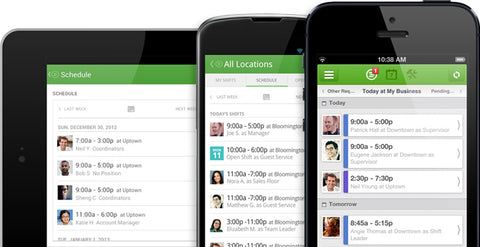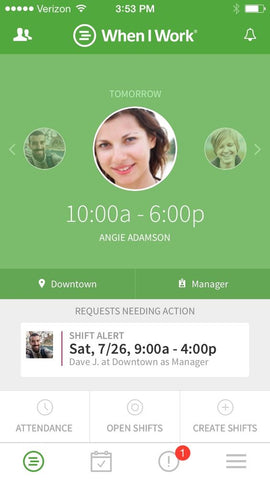Managing staff schedules is a headache that plagues many retailers who employ hourly workers. Staffers may be full-time, part-time, or casual, and merchants must also juggle time off, vacations, and changing shifts.
According to a 2012 study from labor management software firm TimeForge, managers for hotels, restaurants, or offices spend an average of 2.64 hours a week creating staff schedules — and that number jumps to upwards of eight hours weekly for those still using archaic spreadsheets. That’s an entire workday wasted on simply ironing out employee shifts for a single week, which is hardly an efficient use of your time.
While retailers can create schedules by hand, using a spreadsheet, pinging employees through a messaging app, or in a shared calendar, you can make use of more efficient and robust options to quickly manage shifts. Savvy productivity experts have taken their knowledge and packaged it into a handful of cleverly designed apps that can make scheduling simple for you and your staff.
So, save yourself a little time. Rather than toiling for wasted, endless hours juggling calendars and spreadsheets, consider trying one of these effective apps to alleviate the headache of scheduling your staff.
Schedulehead

→Platforms: Web app only
→Cost: Plans range from $0 to $99/month, depending on number of employees and other selected features
With it’s “freemium” subscription model, Schedulehead is a great option for retailers who want to delve deep into software alternatives before making a financial commitment. If you want to review staff scheduling software longer than the 30 day trials some other companies offer, Schedulehead provides a zero-risk way to do so.
Signing up for Schedulehead is straightforward: Simply fill in a brief form and you’ll be sent a verification link via email, confirming your signup.
Once you’ve clicked on the link in the activation email, you can login to yourcompany.schedulehead.com and begin adding employees and shifts. You can add all your staff yourself, or just input their email address and have them setup their own profiles on the desktop version of the app.
You can also set up “skill set” profiles and assign different skills to your employees. This allows the software to intelligently select available employees for shifts in the future. This is a fantastic tool to help differentiate between types of staff members, such as managers and associates, or a server versus a hostess.
Or, if your business has multiple locations, you can add them into the locations toolkit feature. Now when you create your schedule, you can select the retail location for the shift. And once your employees are added and your skill sets are defined, you can start creating shifts and assigning them to staff. You can set time, location, skill set, and number of workers required for a shift, as well as assign specific staff to that shift.
The multiple view options are also wildly helpful to managers. As an administrator, you can view schedules in a list or grid view and then email employees the times they’re assigned. Then on the employee side, you can see your scheduled shifts and request time off.
Overall: Schedulehead has a basic feature set that certainly beats manual scheduling, but falls short of some of the more powerful apps available; not to mention you’ll run into bugs and a clunky user interface to boot. The lack of mobile support is a big oversight given the average person’s on-the-go lifestyle, and feels like a major missed opportunity. If you have any funds to spare on scheduling, more problems could be solved with a meager monthly investment in another app.
When I Work

→Platforms: iPhone, Android, web
→Cost: $9/month and up (pricing based on features and number of users/employees). Free 30-day trial.
When I Work is a robust, feature-rich app that boasts a simple-to-use interface and excellent collaboration functions between employees and employers.
Initial setup is a breeze, even from your smartphone — just type in your business name and let the app find you through Google. If your business isn’t listed, adding it is as simple as filling out a form.
Once your business is in the system, adding positions, employees, skill sets, and shifts are all just as straightforward. And thanks to a handy setup wizard and well-designed platform, you’re never left stumbling through the software, trying to guess what to do next.
When you start adding shifts, you’ll quickly come to appreciate the clickable calendar that's color-coded for various positions, and the ability to save shifts as templates to easily recycle for future schedules. You can view all your shifts in a calendar view by day, week, or month, or as a list — this option is particularly handy on the small screen of a smartphone.
 Once all this information is in place, you can publish your complete schedule and notify your staff via email or text (push notifications aren’t yet available).
Once all this information is in place, you can publish your complete schedule and notify your staff via email or text (push notifications aren’t yet available).
This is where the features of many other scheduling apps end. But When I Work boasts many more functions than the average staff management software. Your staff members can see their schedule, request time off, swap shifts with fellow co-workers (all parties need to agree), setup and receive alerts, and even clock in and out. Staff can also sync their work shifts into their favorite calendar app for easy reminders.
Merchants can see where workers clock in from, thanks to the the built-in GPS on their employee’s phones. So, it's easy to ensure they made it to the correct job site. If someone doesn’t show for their shift, rather than calling all your employees one by one from a lengthy list, you can send out an alert to all staff who have the right skill set profile. The first person available can confirm and clock in, alleviating headaches even from these inevitable unforeseen circumstances.
Finally, When I Work can take the information from your staff schedule and export the data to a compatible payroll program.
Overall: When I Work is powerful software that's chock full of features. The app creators have thought of almost everything and packaged it into a slick, well-designed app that doesn’t require you to be tethered to your desk. There are no free-to-use options after the 30-day trial, but if you have under five employees, the price is very reasonable for all the features you get in return. If you have any budget for scheduling, When I Work is a viable tool to save you time and effort.
ShiftPlanning

→Platforms: iPhone, Android, web
→Cost: $45/month and up (pricing based on features and number of employees). Free 30-day trial.
ShiftPlanning boasts a feature set similar to When I Work at a comparable price point. Unfortunately, the execution isn’t nearly as formidable as the competition. While ShiftPlanning is available for smartphones and desktops, it’s more difficult to get things done on a single platform. Sign up, for example, could only be completed on desktop, as there was no option other than to login on the iOS app.
After creating the company and adding positions on the web platform, the site crashed repeatedly, and returned errors until I refreshed and logged in once again.
Once in the app for the first time, either on web or smartphone, it isn’t immediately obvious where to begin. Where I Work’s step-by-step guides were an added bonus complementing the neatly designed software, but such instructions were a glaring omission in ShiftPlanning’s less navigable interface. But to make up for this shortcoming, ShiftPlanning offers easy to access tech support on every plan.
On the plus side, adding employees is simple in ShiftPlanning, thanks to a quick form that allows managers to add multiple staff members at once.
Assigning positions to staff also seemed easy at first glance, but for some reason, even though I added three staff members during the previous step, I was only given the option to assign two of them to positions. On the next page, I saw the reason for this — only two of the three staff I created were saved. Running into little bugs like this was common throughout the app.
ShiftPlanning also has a calendar that's viewable by day, week, and month, where users add shifts by clicking and entering the hours for each employee. However, the app has a tough time keeping up. I had to slowly and carefully add shifts, or the auto-save feature wouldn’t work and my progress would be (and often was) lost.
You can add worksite locations by clicking on the shift and adding a “New Site,” or selecting one you’ve already made from a list.
A nice feature is the flexible options in setting up repeating shifts, with the ability to quickly select from predictable pre-sets or create a custom schedule. Unfortunately, I found saving a repeating schedule to be another slow task, where the app regularly froze mid-task.
On the mobile side, after I had added all employees and shifts, none of that data was in the app. Confused, I quit and re-launched the app and all my data reappeared. An easy step to do, but one that shouldn’t be necessary. Comparable apps were able to refresh data from the cloud and download updates to the mobile app without a quit and relaunch.
Staff can also request time off and trade shifts with fellow co-workers, but once again, a polished user interface and software stability were lackluster when using these features.
ShiftPlanning does have some useful reporting tools, including position summaries, so you can see the types of employees working most often, view peak hours, and even a daily budget overview so you can see actual versus projected labor costs. You can export most reports into a downloadable spreadsheet, which you could import into Excel, Google Sheets, or another preferred tool. Unfortunately, the reports are as clunky and difficult to use as the rest of the software. While it’s certainly workable, it’s not the best of the bunch.
There’s very little to be said about ShiftPlanning's mobile apps. The Android version is rated three stars in the Google Play store, and the iOS edition I tried was clunky at best. I found I was forced to go back to the web version to perform many functions.
Overall: ShiftPlanning may claim to have some of the same features as Where I Work, but in a far less refined package with little-to-no cost savings. Their reporting tools are decent, but it doesn’t shine enough that I’d recommend it above another software package.
ZoomShift

→Platforms: iPhone, Android, web
→Cost: Plans start at $1.50/month per employee and up for additional features. Free 30-day trial.
ZoomShift is a well-rounded offering with scheduling, shift swapping and reminders, time off requests, budgeting, and data exports all packaged into slick web and mobile apps that include push notifications — a feature the others on this list lack.
Getting started on ZoomShift is easy, both for you as the owner/operator and for your staff. Like Where I Work, both the web and mobile apps support account creation, so you don’t need to be at your desk to get started.
Once you’re in, ZoomShift shows you data as staff first, but it’s easy to switch to the manager dashboard with a single click.
The first time in the “Manager Dashboard” is a bit confusing. There’s places for information about budget, notifications, and schedules, but no clear place to input that information.
After a bit of clicking around, I found the inputs are all under, “Settings.” It’d help to add a quick links menu right on this page, but after learning where to go, it was simple to add staff, positions, and schedules. One shortcoming is the ability to add multiple staff members or positions at once; unfortunately, you’re forced to input them one at a time. While this is tedious, it’s certainly not a deal breaker.
Like the other aforementioned apps, ZoomShift supports multiple locations as well, with the added bonus that you don’t need to know the full address with zip or postal code. You can enter a partial address and the software will verify it so you can use locations when clocking in from your mobile device.
Creating shifts as templates by position is really straightforward as well, allowing you to easily create a common shift and re-use that when scheduling.
ZoomShift is also modular, allowing you to add or remove features with ease through its add-ons panels. If you don’t want employees to be able to swap shifts, for example, you can disable that functionality without impacting the rest of the app.
Another standout feature of ZoomShift is its integrations with popular payment and accounting platforms like Xero and QuickBooks. While it’s still light on software suites they do support, they’ve picked some big ones and it’s an exciting area for further development.
The calendar is color-coded by position, and it’s easy to drag and drop shifts to other days and click to edit them if changes are required. Once you add or update a shift, you can publish and notify your staff of the update, who can then check it on their own device. The calendar also displays the resulting overhead from employing your staff, broken down both by individual member and day of the week.
It’s worth noting that for ZoomShift, most of the owner/operator tasks are on the web app while the mobile versions are geared toward hourly workers. This is a bit of a pain if you want to manage scheduling completely away from your desk. However, the feature set is well designed and useful for staff. Employees can view their scheduled hours, wages, and clock in and out from their smartphones. GPS-enabled phones will let you know that staff have clocked in at the right location, similar to Where I Work.
Overall: ZoomShift is an excellent app, second in features only to When I Work and with some unique bonuses like push notifications, modularity, and external app syncing, that other competitive apps lack. Its per-employee pricing may make it more enticing than some other suites, particularly for smaller retailers.
The Bottom Line
If you’re scheduling staff now with a shared calendar, messaging app, or even an old paper ledger, one of the aforementioned high-tech options could save you time and serious cash. You and your staff can be spared from the complexities of dealing with operational tasks with minimal monetary investment and you can refocus your time and attention on actually building your business.
Have another favorite scheduling tool? Share your suggestions with us in the comments below.

About The Author
Guinevere Orvis is a media strategist, former digital producer, and mother of two young kiddos. She holds an MBA from Ted Rogers School of Management and is enamored with her adopted city of Toronto.
